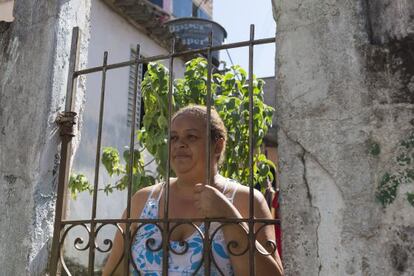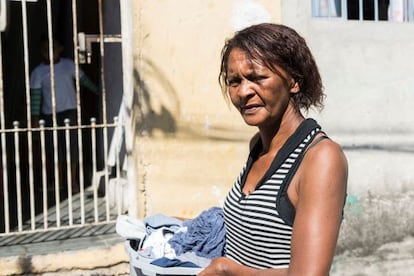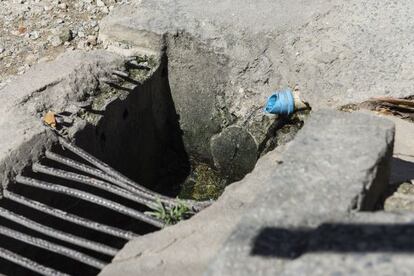The Brazilians learning to live with three hours of water a day
Many São Paulo residents are having to get up in the middle of the night to stock up

In some neighborhoods in Osasco, São Paulo’s fifth-largest municipality, the sun no longer marks the beginning of the day. The day begins here at the crack of dawn, when it is still dark, with the first sound of water running through the pipes. At Janaina Dias’ house, the noise of washing machines, clanking crockery, people washing, and house cleaning begins at 3.30am and ends at 6am, the only hours when the neighborhood has access to water.
They say they barely sleep any more, and don’t need alarms as the water cuts upset their sleep cycles
São Paulo is experiencing its worst drought in 84 years and cuts in supply have been leaving residents without water since last year. The city’s richer neighborhoods, which have large water tanks in their buildings, hardly feel the impact of the shortage. But in the poorer areas of precariously built homes, residents suffer on a daily basis. During those three hours of supply the residents of Jardim Conceição, the most populous neighborhood in Osasco, need to stock up enough water for their families for the entire day. They say they barely sleep any more, and that they don’t need alarms since the cuts upset their sleep cycles and normal routines. “We have been like this for more than six months, our backs hurt from carrying so many buckets,” Janaina says.
Mailsa Alves Moreira, a 49-year-old woman who lives on the same street, walks by, dragging her feet, exhausted, as she carries a washbowl full of clothes nestled against her bony hip. “I work seven days a week,” she says. “If I don’t do the washing now, I don’t know when I will be able to do so. There are 11 of us at home.” Mailsa has been putting loads in the washing machine since 3.30am, taking advantage of this “miracle” Saturday when water is flowing from the faucet, a rare occurrence of late. “It is a cruel situation, you know?” Mailsa says she does not have money to buy a water tank, so if she does not get up and fill some pails with the hose when the water comes on, she would not even have enough to flush the toilet when she gets back home.

The priorities for the residents of these neighborhoods are laundry and enough water to cook. They do not have enough clothes in their closets to postpone laundry days and they do not have the budget to eat out when cuts in supply catch them off guard. According to City Hall, 46.6 percent of Osasco residents live on minimum wage ($262) or less.
Water gushes out of a white pipe on the first step of the stairway that leads up to Andreia Aparecida da Silva’s house in Vila Julia. The pipe is connected to a neighbor’s well and the staircase has become the meeting point for the entire neighborhood. Young kids come here every day to wash their motorcycles and cars. Water trucks come with their drums and mothers come with their buckets, pans and water bottles. “I have even given this water to the kids,” says Andreia, an unemployed 42-year-old mother. “I boiled it and strained it. We didn’t have anything else,” she says, ashamed.
The problem in Jardim Conceição is not just lack of water. The water that does come down the pipes is sometimes unsafe. It’s rare to find a mother giving her child water from the open pipe in the street or even from the faucet. Residents say entire families fell ill with vomiting and diarrhea about two months ago. “The water from the sewage system got mixed up with the water from the pipes,” says 46-year-old Nazaré, who also became sick. “The water coming out of the faucet smelled like shit, the entire street got sick,” she explained. Yet the sewage company says only the ground was contaminated and that they took care of the leak within three days. “We don’t trust it any more, much less give it to the kids,” Janaina says. The damage left them without water for 15 days.

Meanwhile, utility bills do not reflect the inadequacy and inconsistency of the delivery of the service described by residents.“They [the bills] come for $16 but there is no water. It’s been so long I don’t even know when the last Saturday was that I turned on the tap and something came out,” says Andreia. Each member of Andreia’s household uses about 61 liters of water, below the average 126 liters consumed per person each day in São Paulo, and even lower than the average amount recommended by the World Health Organization.
Tu suscripción se está usando en otro dispositivo
¿Quieres añadir otro usuario a tu suscripción?
Si continúas leyendo en este dispositivo, no se podrá leer en el otro.
FlechaTu suscripción se está usando en otro dispositivo y solo puedes acceder a EL PAÍS desde un dispositivo a la vez.
Si quieres compartir tu cuenta, cambia tu suscripción a la modalidad Premium, así podrás añadir otro usuario. Cada uno accederá con su propia cuenta de email, lo que os permitirá personalizar vuestra experiencia en EL PAÍS.
¿Tienes una suscripción de empresa? Accede aquí para contratar más cuentas.
En el caso de no saber quién está usando tu cuenta, te recomendamos cambiar tu contraseña aquí.
Si decides continuar compartiendo tu cuenta, este mensaje se mostrará en tu dispositivo y en el de la otra persona que está usando tu cuenta de forma indefinida, afectando a tu experiencia de lectura. Puedes consultar aquí los términos y condiciones de la suscripción digital.









































